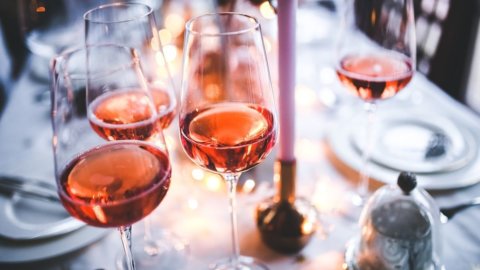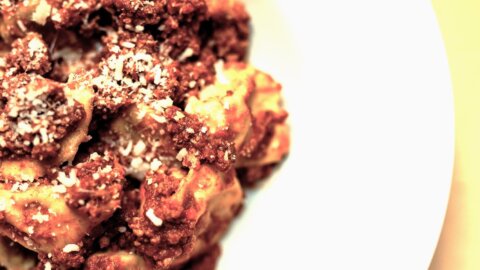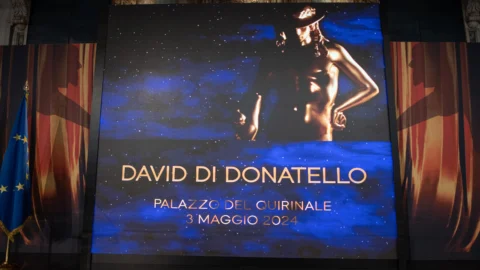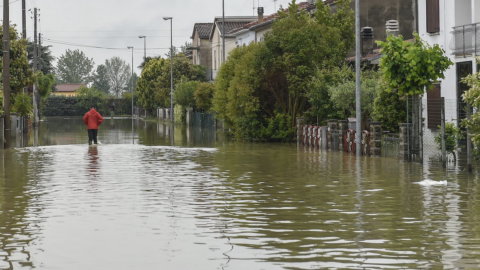Rosé wines to the rescue: the best European rosés will compete in L'Aquila, on the occasion of the Concours Mondial de Bruxelles which moves to Italy from 4 to 6 June, in a particular comparison, Food & Rosé Selection, a challenge on the perfect pairing between food and rose wine. 45 international expert tasters will take care of it - including sommeliers, critics, buyers, journalists and representatives of organizations - who will take on the role of judges to evaluate the combinations of wines awarded with the Great Gold Medals and the Gold Medals of the Rosé Selection by CMB to the dishes offered by the starred cuisine of Magione Papale. Eight coveted Food & Rosé Selection Trophies are up for grabs. D3503804_© Consorzio Vini d'Abruzzo Photo: © Consorzio Vini d'Abruzzo Rome, 21 May 2021.
A pink thread that unites the Europe of wine and the gastronomic excellences of Abruzzo in a competition that will decree the best food-rosé pairing of the year. There will be over 120 labels in the competition, coming from Austria, Belgium, Bulgaria, Spain, France, Italy, Greece, Portugal, Moldavia, Romania and Slovakia, in fact, together with the signature dishes from the kitchen of the starred restaurant Magione Papale (L'Aquila) , the protagonists of the three days in L'Aquila which, in addition to intense tasting sessions, also includes in-depth meetings and debates on the major issues associated with the pink drink.
“Following the success of the Concours Mondial de Bruxelles, which for almost 30 years has now been guiding consumers in the choice of high quality wines at a global level – said Baudouin Havaux, president of the Concours Mondial de Bruxelles and of the Food & Rosé Selection by CMB – we have decided to organize a new competition this year which, in addition to highlighting a global phenomenon such as that of rosés, aims to identify their best pairing with food. A new evaluation criterion therefore, compared to the traditional methods promoted by the Concours Mondial de Bruxelles focused exclusively on wine and organoleptic aspects, which will trace various trends in terms of food and pink wine pairing". All against the backdrop of Abruzzo, one of the most suitable Italian territories for the production of rosé wines, with Cerasuolo d'Abruzzo DOC in the lead, which with 6,2 million bottles a year represents 7% of the bottled product among the Abruzzo PDOs, contributing in a decisive way to the success of this typology and to the positioning of the Belpaese at the top of the world in terms of exports (second step of the podium in value, with 20% of the total shares, and third in volume with 13%, based on the latest data available from the World Observatory of rosé wines).
“Agro-food and more particularly viticulture – adds Emanuele Imprudente, vice president of the Abruzzo Region with responsibility for agriculture – are two real flagships of our region and, not surprisingly, they strongly contribute both to the local economy and to the quality of the Italian offer appreciated all over the world, known as 'Italian Life Style'. Having the honor of organizing the first edition of the Food & Rosé Selection by CMB therefore represents not only a strategic opportunity to promote the excellence of Abruzzo, through the expressions of its territory ranging from wine to oil, from cheeses to cured meats , fishing products and typical products of excellence, but also to offer a renewed impetus to the competitiveness of our territories rich in history, art and scenic beauty, without forgetting the countless natural attractions between sea and mountains".
It begins on Saturday 5 June with the blind tasting sessions, during which the judges will have to classify the labels according to their typicality and their ability to marry with eight specific categories of dishes: aperitif; raw fish; cooked fish; cured meat; cooked meats; spicy foods; cheeses; dessert. Once the potential pairing for each medal-winning wine has been defined, the competition will get to the heart of the competition on Sunday 6 June with a sort of tête-à-tête, where it will be decided which rosé wine will be the best for each food category and therefore which pink label will conquer one of the eight Food & Rosé Selection Trophies foreseen by the competition (Best rosé wine as an aperitif; Best rosé wine for raw fish; Best rosé wine for cooked fish; Best rosé wine for cured meats; Best rosé wine for cooked meat; Best wine rosé for spicy food; Best rosé for cheese; Best rosé for dessert).
In fact, in the final phase, the jurors will again taste the wines previously evaluated blindly, but this time together with the dish of the category to which they were assigned. Finally, the Food & Rose Selection by CMB program will be enriched by four meetings-debates on topics of greatest interest to the rosé wine sector (also available in streaming), which range from global trends to the main technical evolutions in production, up to packaging and marketing, passing through the focus on Italian rosés from native grapes.
The four meetings-debates of the Food & Rosé Selection by CMB (also visible live and always available on the Concours Mondial de Bruxelles YouTube account: https://www.youtube.com/user/Vinopres): Friday 4 June, at 17.30 – Palazzo della Regione “CERASUOLO, CHIARETTO, ROSATO: ITALIAN ROSÉ FROM NATIVE GRAPES” By Davide Acerra, administrator and communication manager of the Consortium for the Protection of Abruzzo Wines (Italian language, with simultaneous translation into English) . Friday 4 June, 18.30 pm – Palazzo della Regione “PAST, PRESENT AND FUTURE OF ROSE WINE: MAIN TECHNICAL EVOLUTION AND CONSEQUENCES ON THE PRODUCT” By Gilles Masson & Nathalie Poulzagues, respectively director and project manager of the Wine Research and Experimentation Center rosé in Provence (French language, with English translation).
Saturday 5 June, 8.45 am – Magione Papale “GLOBAL WINE TRENDS: THE OPPORTUNITY OF ROSÉ” By Pierpaolo Penco, food and wine marketing consultant of Affinamenti and Italy Country Manager of Wine Intelligence (English). Sunday 6 June, 8.45 am – Magione Papale “THE NEW FRONTIERS OF PACKAGING AND MARKETING OF ROSE WINES” By Kateřina Slezáková and Gaia Gottardo, respectively Vinolok marketing manager and Vinolok distributor at Amorim Cork Italia SpA (English language).
According to data from the World Observatory of rosés, global production of rosé wine rose from 20 million hectoliters in 2002 to a record level of 26,4 million hectoliters in 2018, an increase of 31%. After a period of significant decline between 2014 and 2017, France experienced a rapid recovery in 2018, going from 5,5 million hectoliters in 2017 to 7,5 million in 2018. Production has also reached a record level in the United States, with 5 million hectoliters, and in Spain which, after a constant decline since 2013, has reached its highest level in the last ten years. The podium of the main rosé-producing countries in 2018 is therefore made up of France, the United States and Spain, which together account for 64% of rosé wine production in volume worldwide, compared to 60% in 2017.
In Italy, on the other hand, production has halved in the last ten years, although a slight recovery was recorded in 2018. Consumption In 2018, more than 11 liters out of 25,6 still wines drunk were rosé. Global consumption of rosé, in fact, with 11,2 million hectoliters represents 34% of global wine consumption. The two main consuming countries are France (which absorbs 3% of global volumes, +10% in 20 years) and the United States (4% of global consumption, +10% in 2002 years). On the contrary, in the last ten years, Germany, Italy and Spain have seen their consumption decrease, with Spain in the black jersey in particular (since 70 -XNUMX%).
Global rosé exports grew by 39%, from 7,6 million hectoliters in 2002 to 10,6 million hectoliters in 2018. All leading countries increased their export volumes. Taking the lion's share: Spain (40%), France (14%) and Italy (13%) which account for two-thirds of global rosé exports. In value, on the other hand, exported rosé wines reached +10% in 2018, going from 2 billion euros in 2017 to 2,2 billion euros in 2018.





